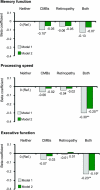Cerebral microbleeds, retinopathy, and dementia: the AGES-Reykjavik Study
- PMID: 21172845
- PMCID: PMC3013588
- DOI: 10.1212/WNL.0b013e3182020349
Cerebral microbleeds, retinopathy, and dementia: the AGES-Reykjavik Study
Abstract
Objective: To determine whether microvascular damage, indicated by cerebral microbleeds (CMBs) and retinal microvascular signs, is associated with cognitive function and dementia in older persons.
Methods: This is a cross-sectional study of 3,906 participants (mean age 76 years; 58% women) in the AGES-Reykjavik Study (2002-2006). We assessed CMBs on MRI and retinal microvascular signs on digital retinal images. Composite Z scores of memory, processing speed, and executive function were derived from a battery of neurocognitive tests. Dementia and subtypes were diagnosed following international criteria. Regression models were used to relate cognitive Z scores and dementia to CMBs and retinal microvascular signs, adjusting for demographics, cardiovascular factors, and brain ischemic lesions.
Results: People with multiple (≥ 2) CMBs had lower Z scores on tests of processing speed (β-coefficient -0.16; 95% confidence interval -0.26 to -0.05) and executive function (-0.14; -0.24 to -0.04); results were strongest for having multiple CMBs located in the deep hemispheric or infratentorial areas. The odds ratio of vascular dementia was 2.32 (95% confidence interval 1.02 to 5.25) for multiple CMBs and 1.95 (1.04 to 3.62) for retinopathy. Having both CMBs and retinopathy, compared to having neither, was significantly associated with markedly slower processing speed (-0.25; -0.37 to -0.12), poorer executive function (-0.19; -0.31 to -0.07), and an increased odds ratio of vascular dementia (3.10; 1.11 to 8.62).
Conclusion: Having multiple CMBs or concomitant CMBs and retinopathy is associated with a profile of vascular cognitive impairment. These findings suggest that microvascular damage, as indicated by CMBs and retinopathy lesions, has functional consequences in older men and women living in the community.
Figures


References
Publication types
MeSH terms
Grants and funding
LinkOut - more resources
Full Text Sources
Medical
